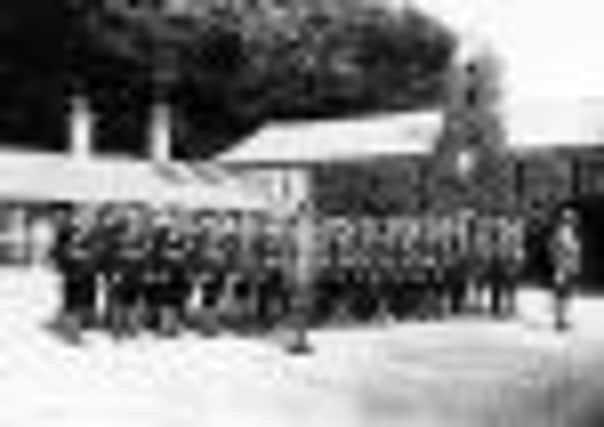Tinderbox: Ballymena and the Ulster Covenant


By 1913, George Young was the local commander of the newly-formed Ulster Volunteer Force and he was busily employed in giving orders to the men who were under his command as well as corresponding with his superiors in the movement such as James Craig and Sir Edward Carson.
In recent times, a superb collection of this correspondence has emerged, which tells the story of the Mid-Antrim Ulster Volunteers and affords great insight into the way that Unionists were thinking, as they faced a political outcome that disturbed them deeply and which they were prepared to take up arms to oppose. This trove of invaluable historical material is now in the keeping of the Mid-Antrim Museum and the author Philip Orr – well-known for work on the Ulster Division at the Battle of the Somme – was commissioned by the Museum to make the correspondence of George Young the basis for a book which tells the story of Ballymena and its hinterland in these stirring and dangerous times.
Advertisement
Hide AdAdvertisement
Hide AdPhilip has added further information culled from newspapers and other written sources as well as employing photographs located in the museum archives, in order to bring the period of the Home Rule Crisis alive for the modern reader. This is not just the story of local Unionism but also of local Nationalists, who had been looking forward to the restoration of a Dublin parliament within the British Empire and who were deeply disappointed by the prospect of losing that parliament before it had ever got ‘off the ground’.
Philip’s book spends much time telling the story of the Ulster Covenant in and around Ballymena. In an attempt to create a peaceful mass-protest amongst Unionists, their leaders had devised a document that would sum up the reasons for rejecting Home Rule and give voice to the intensity of their opposition. On September 28th 1912, Mid-Antrim joined the rest of Ulster in a day of protest and prayer to God for deliverance, known as Ulster Day. During the course of this day, almost all of Ballymena’s Protestant churches were packed with people who had come to hear their clergy speak of the evil that they believed lay ahead, if the British government did not listen to the voice of Ulster’s loyal Protestants. Men of the local Unionist Clubs marched in military formation through the town centre and the Covenant was available to sign in a wide range of venues, such as church halls and Orange Halls and also in the People’s Park and at a few other outdoor locations.
Men from the age of 16 upwards were eligible to add their names, irrespective of their social class or religious denomination. Women from the district also had a chance to sign the Ulster Covenant, putting their names to a separate document known as the Declaration. In due course, the signatures were collected and counted. The hundreds of thousands of signatures were seen as the ultimate proof that Ulster Unionists meant business.
Although the famous Unionist leader, Sir Edward Carson, did not appear in Ballymena on Ulster Day, he had appeared in the district not long before and had been greeted as a hero by much of the local populace. He would return in 1913, with his carriage pulled through the streets from the railway station towards the Fair Hill, where he addressed the crowd from a platform decorated with bunting and then inspected the men of the local battalion of the Ulster Volunteer Force. However there was, as yet, no sign of the government changing its mind about Irish Home Rule and so by the spring of 1914, guns were on their way to Ulster. On a dark April night, vehicles from Ballymena made their way to Larne harbour in order to load up with the rifles that had been smuggled in from Germany by Fred Crawford, the famous gun-runner. Local Unionists, like their colleagues elsewhere in the north of Ireland, aimed to fight, if they did not get their way.
Advertisement
Hide AdAdvertisement
Hide AdHowever, not all of the local population feared the Gaelic culture which had made such strides in recent years, especially in places such as the nearby Antrim Glens. Indeed, a number of local Protestants showed little fear of Irish Nationalism. Rose Young, George Young’s sister, was a fluent Irish speaker, who taught the language at classes in the district. Sir Roger Casement – an orphaned relative of the Young family, who had been schooled in Ballymena – was a very keen Nationalist. Jack White was the son of Sir George White, the hero of Ladysmith but his political views were very different from his father’s. He had left the army and had become an anarchist as a young man. By 1912 he was becoming committed to revolutionary socialism, helping to form the Irish Citizens’ Army in the following year, with another ex-soldier and Labour activist, James Connolly.
By early August 1914, a terrible European war would break out and the crisis-ridden Home Rule project that had gripped Ulster would be put on hold for four years. Many men from Mid-Antrim would pull on a British Army uniform and be drafted into the forces, heading for service in the trenches of the Western Front. Too many would not come back, leaving their names on local war-memorials for all future generations to see the depth and extent of their youthful sacrifice.
Philip Orr’s new book is entitled New Perspectives – Politics, Religion and Conflict in Mid-Antrim, 1911-14 and it is available from the tourist information centre at The Braid costing £9.99. Anyone who wishes to gain a proper insight into the amazing political events that engulfed the lives of the people of Ballymena one hundred years ago, should buy and read Philip’s excellent book. For further information or to order your copy please tel: (028) 2565 7161 or email: [email protected]